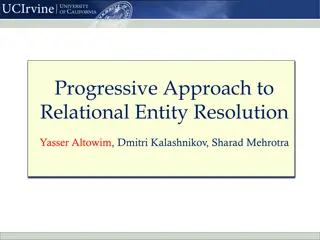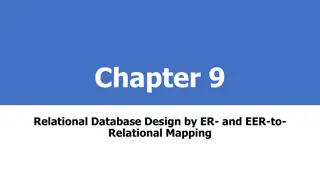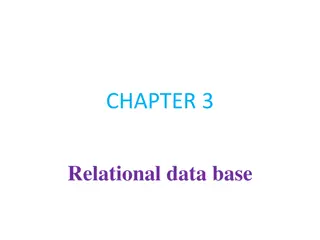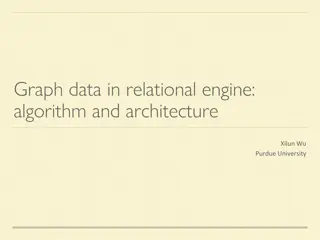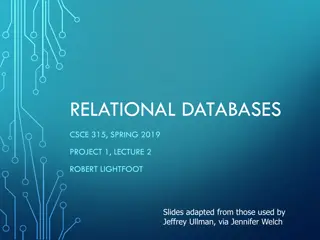
Entity Relationship Diagrams and Cardinality in Relational Database Modeling
This content provides insights into the fundamentals of relational database modeling, focusing on Entity Relationship Diagrams (ERDs) and Cardinality. It explains the key elements of ERDs, such as entities, attributes, and relationships, along with the Crow's Foot Notation for denoting cardinality. Additionally, it clarifies the concepts of maximum and minimum cardinality and illustrates how to interpret these notations in entity relationships. By exploring ERDs and cardinality, you can enhance your understanding of how entities are structured and interconnected in a database model.
Download Presentation

Please find below an Image/Link to download the presentation.
The content on the website is provided AS IS for your information and personal use only. It may not be sold, licensed, or shared on other websites without obtaining consent from the author. If you encounter any issues during the download, it is possible that the publisher has removed the file from their server.
You are allowed to download the files provided on this website for personal or commercial use, subject to the condition that they are used lawfully. All files are the property of their respective owners.
The content on the website is provided AS IS for your information and personal use only. It may not be sold, licensed, or shared on other websites without obtaining consent from the author.
E N D
Presentation Transcript
MIS2502: MIS2502: Data Analytics Data Analytics Relational Data Modeling 2 Relational Data Modeling 2 Zhe (Joe) Deng deng@temple.edu http://community.mis.temple.edu/zdeng 1
The Entity Relationship Diagram (ERD) The Entity Relationship Diagram (ERD) The primary way of modeling a relational database ER Diagrams --- are sketches like this one! Primary Key TUID Course number Cardinality Name Course Student contains Attribute Entity Relationship Course Title GPA
The Entity Relationship Diagram (ERD) The Entity Relationship Diagram (ERD) Three main diagrammatic elements A uniquely identifiable thing (i.e., person, order) Rectangle Entity A characteristic of an entity or relationship (i.e., first name, order number) Attribute Ellipse Describes how two entities relate to one another (i.e., makes) Relationship Diamond
Last component: Cardinality Last component: Cardinality Crow s Foot Notation Customer Order makes There are other ways of denoting cardinality, but this one is pretty standard. So called because this looks something like this There are also variations of the crows feet notion!
Cardinality Cardinality Defines the rules of the association between entities Maximum cardinality (Close to entities) Customer Order makes Minimum cardinality (Close to relationship) Maximum cardinality Describes the maximum number of entities that participate in a relationship (either or ) Minimum cardinality Describes the minimum number of entities that must participate in a relationship (either or )
Cardinality Cardinality How to understand the notations: Entity Relationship Cardinality Entity Customer Order makes Minimum cardinality: Maximum cardinality: at least one at least zero (optional) at most - one at most - many Maxinum cardinality: One customer can have many orders. One order can only belong to one customer. Minimum cardinality: A customer could have no orders. An order has to belong to at least one customer.
Maximum and Minimum Cardinality Maximum and Minimum Cardinality Maximum cardinality (type of relationship) Describes the maximum number of entity instances that participate in a relationship One-to-one One-to-many Many-to-many Minimum cardinality Describes the minimum number of entity instances that must participate in a relationship Either optional or mandatory
Maximum cardinality: Maximum cardinality: One One- -to to- -One Relationship One Relationship One-to-One (1:1) A single instance of one entity is related to a single instance of another entity A state has (at most) one governor A governor governs (at most) one state
Maximum cardinality: Maximum cardinality: One One- -to to- -Many Relationship Many Relationship One-to-Many (1:n or 1:m) A single instance of one entity is related to multiple instances of another entity A publisher can publish many books A book is published by (at most) one publisher
Maximum cardinality: Maximum cardinality: Many Many- -to to- -Many Relationship Many Relationship Many-to-Many (n:n or m:m) Each instance of one entity is related to multiple instances of another entity, and vice versa A book can be written by many authors An author can write many books
Minimum Cardinality Minimum Cardinality Minimums are generally stated as either zero or one: 0 (optional): participation in the relationship by the entity is optional. 1 (mandatory): participation in the relationship by the entity is mandatory. A programmer is mandatory for a certificate); or a certificate has to be issued to (at least) one programmer. A certificate is optional for a programmer; or a programmer may not have any certificates 1:m maximum cardinality: a programmer can have many certificates; a certificate is issued to (at most) one programmer
Crows Foot Notation Summary Crow s Foot Notation Summary Symbol Minimum Cardinality + Maximum Cardinality Optional + One Mandatory + One Optional + Many Mandatory + Many
The Order The Order- -Product Example: Product Example: A Many A Many- -to to- -Many ( Many (m:m An order can be composed of many products. An order has to have at least one product. A product can be a part of many orders. A product has to be associated with at least one order. m:m) Relationship ) Relationship Order number Order Date Order at most many at least one Quantity contains at least one at most - many Does it make sense for the maximum cardinality to be 1 for either entity? Product name Product Product ID Does it make sense for the minimum cardinality to be 0 (optional) for either entity? Price
Relationship Attributes Relationship Attributes TUID Name The grade and semester describes the combination of student and course Student Grade contains (i.e., Bob takes MIS2502 in Fall 2011 and receives a B; Sue takes MIS2502 in Fall 2012 and receives an A) Semester Course Course number Course Title
Cardinality is defined by business rules Cardinality is defined by business rules What would the cardinality be in these situations? ? ? Order Product contains ? ? Course Section has ? ? Employee Office has
A scenario: A scenario: The auto repair shop The auto repair shop A car is described by a VIN, make, and model. Each transaction is associated with a car, a mechanic, and a repair. A mechanic is described by a name and SSN. Cars, mechanics, and repairs can all be part of multiple transactions. A repair is described by a price. Many transactions can make up an invoice. A transaction occurs on a particular date. A transaction can only belong to one invoice. An invoice has an invoice number and a billing name, city, state, and zip code.
Solution: Solution: Entities Entities
Solution: Solution: EDR EDR TIPS: ONE relationship can ONLY link TWO entities. If one needs more connections, it should be a NEW entity! (E.g., transaction, order, record, etc.)
Normalization Normalization Organizing data to minimize redundancy (repeated data) This is good for several reasons The database takes up less space Fewer inconsistencies in your data Easier to search and navigate the data It s easier to make changes to the data The relationships take care of the rest
Normalizing your ER Model Normalizing your ER Model If an entity has multiple sets of related attributes, split them up into separate entities Vendor Name Don t do this Vendor Phone Vendor Address Vendor Name Vendor Phone Vendor ID Vendor Address Vendor Product ID Product name Product sells do this Price Product name Product Then you won t have to repeat vendor information for each product. Product ID Price
Normalizing your ER Model Normalizing your ER Model Each attribute should be atomic you can t (logically) break it up any further. do this Don t do this First Name Phone Phone Address Customer ID Customer ID First/Last Name Customer Last Name Customer City State Zip Street This way you can search or sort by last name OR first name, and by city, state, or zip code.
Summary of ERD Summary of ERD Key concepts Entity Relationship Attributes Entity attributes: primary key vs. non-key Relationship attributes Cardinality Minimum cardinality: optional or mandatory (i.e., 0 or 1) Maximum cardinality: 1:1, 1:m, m:m Crow s foot notation Key skills Interpret simple ERDs Draw an ERD based on a scenario description
Mapping natural language Mapping natural language English grammar structure ER structure Proper noun Entity Transitive verb Relationship type Adjective Adverb Attribute for entity Attribute for relationship Chen, P. P. S. (1997). English, Chinese and ER diagrams. Data & Knowledge Engineering, 23(1), 5-16.
Drawing ERD With Drawing ERD With ERDPlus ERDPlus: A Checklist : A Checklist Entities Entity attributes Primary key Non-key attributes Relationships Minimum cardinality Maximum cardinality Relationship attributes
Time for our 2 Time for our 2nd nd ICA! ICA!

